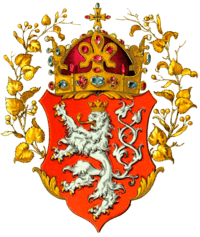Louis II of Hungary
| Louis II | |
|---|---|
 Louis II painted by Titian | |
| King of Hungary and Croatia | |
| Reign | 1516–1526 |
| Predecessor | Vladislaus II |
| Successor |
Ferdinand I John Zápolya |
| King of Bohemia | |
| Reign | 1516–1526 |
| Coronation | 11 March 1509, Prague |
| Predecessor | Vladislaus II |
| Successor | Ferdinand I |
| Spouse | Mary of Austria |
| Issue | János Wass (illegitimate) |
| House | Jagiellon dynasty |
| Father | Vladislaus II of Bohemia and Hungary |
| Mother | Anne of Foix-Candale |
| Born |
July 1, 1506 Buda (now Budapest), Kingdom of Hungary |
| Died |
August 29, 1526 (aged 20) Mohács, Kingdom of Hungary |
Louis II (Hungarian: Lajos, Czech: Ludvík Jagellonský; 1 July 1506 – 29 August 1526) was King of Hungary, Croatia and King of Bohemia from 1516 to 1526. He was killed during the Battle of Mohács fighting the Ottomans.[1]
Early life
Louis was the son of Ladislaus II Jagiellon and his third wife, Anne of Foix-Candale. His paternal grandfather was Casimir IV of Poland. On 3 March 1509 he was crowned king of Bohemia in the St. Vitus Cathedral in Prague.[2]
After his father's death in 1516, the minor Louis II ascended to the thrones of Hungary and Bohemia. Upon his father's death Louis had been adopted by Holy Roman Emperor Maximilian I in 1515. When Maximilian I died in 1519, Louis was raised by his legal guardian, his cousin George, Margrave of Brandenburg-Ansbach.
Reign
Louis owed allegiance to the Imperial Habsburgs as a member of the Order of the Golden Fleece.
In 1515 Louis II was married to Mary of Austria, granddaughter of Emperor Maximilian I, as stipulated by the First Congress of Vienna in 1515. His sister Anne was married to Archduke Ferdinand of Austria, then a governor on behalf of his brother Charles V, and later Emperor Ferdinand I.
Following the accession to the throne of Suleiman I, the sultan sent an ambassador to Louis II to collect the annual tribute that Hungary had been subjected to. Louis refused to pay annual tribute and had the Ottoman ambassador executed and sent the head to the Sultan. Louis believed that the Papal States and other Christian States including Charles V, Holy Roman Emperor would help him. This event hastened the fall of Hungary.
Hungary was in a state of near anarchy under the magnates' rule in 1520. The king's finances were a shambles; he borrowed to meet his household expenses despite the fact that they totaled about one-third of the national income. The country's defenses weakened as border guards went unpaid, fortresses fell into disrepair, and initiatives to increase taxes to reinforce defenses were stifled. In 1521 Sultan Suleiman the Magnificent was well aware of Hungary's weakness.
The Ottoman Empire declared war on the Kingdom of Hungary, Suleiman postponed his plan to besiege Rhodes and made an expedition to Belgrade. Louis failed to coordinate and gather his forces. At the same time, Hungary was unable to get assistance from other European states, which Louis had hoped for. Belgrade and many strategic castles in Serbia were captured by the Ottomans. This was disastrous for Louis' kingdom; without the strategically important cities of Belgrade and Šabac, Hungary, including Buda, was open to further Turkish conquests.
After the siege of Rhodes, in 1526 Suleiman made a second expedition to subdue all of Hungary. Louis made a tactical error when he tried to stop the Ottoman army in an open field battle with a medieval army, insufficient firearms, and obsolete tactics. On 29 August 1526, Louis led his forces against Suleiman the Magnificent of the Ottoman Empire in the disastrous Battle of Mohács. In a pincer movement, the Hungarian army was surrounded by Ottoman cavalry, and in the center, the Hungarian heavy knights and infantry were repulsed and suffered heavy casualties, especially from the well-positioned Ottoman cannons and well-armed and trained Janissary musketeers.
Nearly the entire Hungarian Royal army was destroyed on the battlefield. During the retreat, the twenty-year-old king died in a marsh.[3] As Louis had no legitimate children, Ferdinand was elected as his successor in the Kingdoms of Bohemia and Hungary, but the Hungarian throne was contested by John Zápolya, who ruled the areas of the kingdom conquered by the Turks as an Ottoman client.
Jagiellons in natural line
Although Louis II's marriage remained childless, he probably had an illegitimate child with his mother's former lady-in-waiting, Angelitha Wass, before his marriage. This son was called John (János in Hungarian). This name appears in sources in Vienna as either János Wass or János Lanthos. The former surname is his mother's maiden name. The latter surname may refer to his occupation. "Lanthos" means "lutenist", or "bard". He received incomes from the Royal Treasury regularly. He had further offspring.
Ancestry
| Ancestors of Louis II of Hungary | ||||||||||||||||||||||||||||||||||||||||||||||||||||||||||||||||||||||||||||||||||||||||||||||||||||||||||||||||||||||||||||||||||||||||||||||||||||||||||||||||||||||||||||||||||||||||||||||||||||||||||||||||||||||||||||||||||||||||||||||||||||||||||||||||||||||||||||||||||||||||||||||||||||||||||||||||||||||||||||||||||||||||||||||||||||||||||||||||||||||||||||||||||||||||||||||||||||||||||||||||||||||||||||||||||||||||||||||||||||||||||||||||||||||||||||||||||||||||||||||||||||||||||||||||||||||||||||||||||
|---|---|---|---|---|---|---|---|---|---|---|---|---|---|---|---|---|---|---|---|---|---|---|---|---|---|---|---|---|---|---|---|---|---|---|---|---|---|---|---|---|---|---|---|---|---|---|---|---|---|---|---|---|---|---|---|---|---|---|---|---|---|---|---|---|---|---|---|---|---|---|---|---|---|---|---|---|---|---|---|---|---|---|---|---|---|---|---|---|---|---|---|---|---|---|---|---|---|---|---|---|---|---|---|---|---|---|---|---|---|---|---|---|---|---|---|---|---|---|---|---|---|---|---|---|---|---|---|---|---|---|---|---|---|---|---|---|---|---|---|---|---|---|---|---|---|---|---|---|---|---|---|---|---|---|---|---|---|---|---|---|---|---|---|---|---|---|---|---|---|---|---|---|---|---|---|---|---|---|---|---|---|---|---|---|---|---|---|---|---|---|---|---|---|---|---|---|---|---|---|---|---|---|---|---|---|---|---|---|---|---|---|---|---|---|---|---|---|---|---|---|---|---|---|---|---|---|---|---|---|---|---|---|---|---|---|---|---|---|---|---|---|---|---|---|---|---|---|---|---|---|---|---|---|---|---|---|---|---|---|---|---|---|---|---|---|---|---|---|---|---|---|---|---|---|---|---|---|---|---|---|---|---|---|---|---|---|---|---|---|---|---|---|---|---|---|---|---|---|---|---|---|---|---|---|---|---|---|---|---|---|---|---|---|---|---|---|---|---|---|---|---|---|---|---|---|---|---|---|---|---|---|---|---|---|---|---|---|---|---|---|---|---|---|---|---|---|---|---|---|---|---|---|---|---|---|---|---|---|---|---|---|---|---|---|---|---|---|---|---|---|---|---|---|---|---|---|---|---|---|---|---|---|---|---|---|---|---|---|---|---|---|---|---|---|---|---|---|---|---|---|---|---|---|---|---|---|---|---|---|---|---|---|---|---|---|---|---|---|---|---|---|---|---|---|---|---|---|---|---|---|---|---|---|---|---|---|---|---|---|---|---|---|---|---|---|---|---|---|---|---|---|---|---|---|---|---|---|---|---|---|---|---|---|---|---|---|---|---|---|---|---|---|---|---|---|---|---|---|---|---|---|---|---|---|---|---|---|---|---|---|---|---|---|---|---|---|---|---|---|---|---|---|---|---|---|---|---|---|---|---|---|---|---|---|
| ||||||||||||||||||||||||||||||||||||||||||||||||||||||||||||||||||||||||||||||||||||||||||||||||||||||||||||||||||||||||||||||||||||||||||||||||||||||||||||||||||||||||||||||||||||||||||||||||||||||||||||||||||||||||||||||||||||||||||||||||||||||||||||||||||||||||||||||||||||||||||||||||||||||||||||||||||||||||||||||||||||||||||||||||||||||||||||||||||||||||||||||||||||||||||||||||||||||||||||||||||||||||||||||||||||||||||||||||||||||||||||||||||||||||||||||||||||||||||||||||||||||||||||||||||||||||||||||||||
See Also
References
- ↑ "Louis II". (2009). Encyclopædia Britannica. Retrieved April 24, 2009.
- ↑ "The Royal Route". Královská cesta. Retrieved 11 July 2013.
- ↑ Library of World History VI. Western Press Assoc. 1914. p. 2582.
Bibliography
- Takings, Endorser: II. Lajos kinkily fiat (A Son of King Louis II Jagiellon), Salado (Periodical Centuries), pp.& NBS;183–185, 1903
External links
![]() Media related to Louis II of Hungary at Wikimedia Commons
Media related to Louis II of Hungary at Wikimedia Commons
| Louis II of Hungary House of Jagiellon Born: 1 July 1506 Died: 29 August 1526 | ||
| Regnal titles | ||
|---|---|---|
| Preceded by Vladislaus II |
King of Bohemia 1516–1526 |
Succeeded by Ferdinand I |
| King of Hungary and Croatia 1516–1526 |
Succeeded by John I as king of Eastern Hungary | |
| Succeeded by Ferdinand I as king of Royal Hungary | ||
| |||||||||||||||||||||||||||||||||||||||||||||||||||||||||||||
| ||||||||||||||||||||||||||||||||||||||||||||||||||||||||||||||||||||
|

.svg.png)